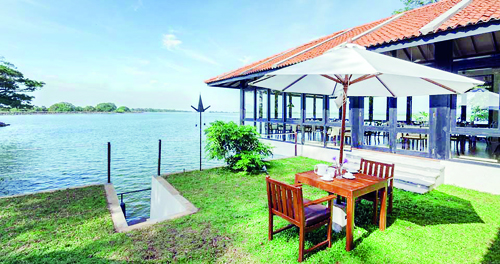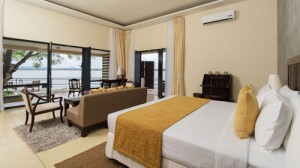House on the Lake with memories of bygone Rest House days
Heading up the bund of the Parakrama Samudraya in Polonnaruwa, a sense of tranquillity resonates from the surroundings. The warm copper shade spread over the lake blends beautifully with the orange tinge of the sky, as a few hundred cormorants swoop down on us. Our gaze follows their trail to a quaint little establishment towards the right end of the bund.
The more travelled of us make the immediate connection that it is none other than the beloved Polonnaruwa Rest House, now renamed ‘The Lake House’ – that once hosted royalty – Britain’s Queen Elizabeth II herself.
Bringing back her glory days, the Lake House, with the completion of timely renovations, is quite literally fit for a queen again.
Queen Elizabeth’s 1954 tour of Ceylon was incidentally only five months after her coronation. Many will recall the royal procession through Colombo, and the grand reception hosted by then Prime Minister, Sir John Kotelawala, followed by the Queen opening the first session of the second Parliament of Ceylon in her coronation gown.
Following her official duties, the Queen took an extensive journey to see the country and one of her stops was the Polonnaruwa Rest House.
Built in 1870, the Polonnaruwa Rest House was initially a circuit bungalow for British Government Agents. It was taken over by the Ceylon Tourist Bureau in 1954 and named the Polonnaruwa Rest House. It was subsequently transferred to the Ceylon Hotels Corporation.
“There is a sense of uniqueness in the rest houses across Sri Lanka,” says Deepal Amarasinghe, General Manager of the Lake House and the Safari Tissamaharama. “It’s because of the specifically chosen locations that each is situated in.”
The Lake House offers the best views of the Parakrama Samudraya and we learn that the Queen’s room and the restaurant jutting out onto the lake was built especially for her. Inside the Queen Suite, one can still find the jewellery box and mirror used by Her Majesty.
While the royal visit is a badge of honour, rest houses over Sri Lanka were always the chosen option of the common traveller, looking to holiday with the family at an affordable rate. “The Rest House concept is still present, and people like to make the connection with days gone by. We still open for lunch hours to tourists passing through who want to have a quick lunch and refresh,” says Mr. Amarasinghe.

A room fit for a Queen: The Queen Suite with jewellery box and all
The next stop on our journey takes us further left across the lake to another establishment owned by the Ceylon Hotels Corporation – The Lake Hotel.
In close proximity to the magnificent Parakrama Samudraya, the cosy Lake Hotel beams with both simplicity and rustic elegance. Built on three acres of landscaped garden, the hotel boasts 40 air-conditioned deluxe rooms with all modern amenities and has undergone extensive renovation.
Built on two levels, the hotel gives tourists generous views of the Parakrama Samudraya. At 21,000 hectares (5600 acres), the great artificial lake is at once a statement of imperial power and a monumental feat of engineering; irrigating 18,000 acres of paddy fields for two seasons a year. From the Lake Hotel, one can blissfully revel in the peaceful beauty of the lake.
Its creator, King Parakramabahu the Great (1164-1196 AD) famously stated that “Not one drop of water must flow into the ocean without serving the purposes of man”, and the verity of his words is seen by the immense sense of life that the Parakrama Samudraya adds to the surroundings.
There is a great sense of culture and locality intertwined with the hotel, starting right from the refreshing welcome drinks -mango, ambarella and cinnamon iced tea to the Kevum achchi who sits by the lakeside frying the traditional oil cakes for visitors at tea time.
The cuisine at the Lake Hotel relies on Sri Lankan dishes that bring out the best of the region. While we indulged in steaming hot rice with kiri-kos, kalu pol, mallum, wew maalu and an array of local dishes, one can also enjoy exclusive seafood dishes. Naturally, we opted for the King of crustaceans – the Spiny Lobster, and it was a memorable culinary treat.
One of the highlights of the Lake Hotel is that it offers easy access to the ancient ruins of Polonnaruwa. Tourists can choose to bike to the ruins -with bicycles being provided by the hotel- or take a quick drive.
The ancient city of Polonnaruwa is a UNESCO World Heritage site, and it is easy to see why as our eyes meet the vast garden-kingdom of ruins that was once home to skilled craftsmen, and great kings of the past.
The ancient palace of King Parakramabahu the Great, known as the Weijantha Prasada is said to have been seven storeys tall, housing a thousand chambers. What remains today is the evocative front facade and several chambers that housed the King and his Queens.
The Nissanka Latha Mandapaya or “Flower Scroll Hall” built by King Nissanka Malla and named after him, is located near the western entrance of the Dalada Maluva, the area that contains the oldest and most sacred monuments in the city.
The Atadage is the first Tooth Relic Temple of Polonnaruwa, built by King Vijayabahu in the 11th century. Two further Tooth Relic Temples, known as the Vatadage and the Hatadage built by subsequent kings can also be seen.
Among the ruins is the monumental Gal vihara, which houses four statues of the Buddha in different stances or mudhras, carved into granite rock. It is considered among the best examples of rock carving and sculpture of the ancient Sinhalese.
Among the other sites, the Alahana Pirivena, Lankathilakaya, Nelum Pokuna, Thivanka Pilimage, Rankoth Vehera and the Pulasthi statue are all of historic interest.
Approximately 20 kilometres away is the Minneriya National Park where tourists can now view ‘The Gathering’ where large herds of elephants are seen around the watering holes. The open-top jeep rides are convenient (but mind you, bumpy) and can also be arranged with the management of the hotel.
The Galle Face Hotels Group manages the Ceylon Hotels Corporation properties and the Lake House and Lake Hotel come under their distinctive Resorts Collection, that also includes the Surf Hotel Bentota and the Safari Hotel, Tissamaharama.


